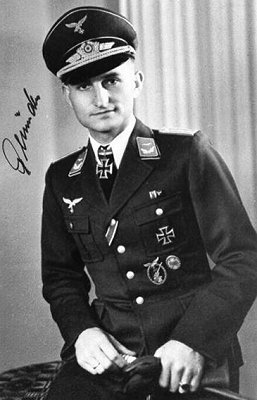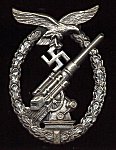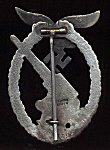
The anti-aircraft combat badge institution was ordered on January 10, 1941 by Reichsmarschall Hermann Göring. It had been designed by W.E. Peekhaus of Berlin in the summer of 1940.
Manufacturing and Technical Information
The badge consists of an 8.8cm anti aircraft gun, surrounded by an oak leaves crown , surmounted by a soldered or riveted Luftwaffe eagle. On the reverse there is a thin needle round pin. In most cases, a rounded cut out portion can be observed under the gun barrel.
The badge was fabricated in tombac later in zinc.
- Height : 56.3mm to 56.9mm
- Wide : 43.5mm to 46mm
- Eagle : 39.9mm to 40.9mm
- Weight : 26g to 41.8g
On January 1941, the firm C.E.Juncker of Berlin was in charge of production, then other firms followed. Other makers are:
- BREHMER MARKNEUKIRCHEN G.B.(Gustav Brehmer Markneukirchen)
- C.E. JUNCKER BERLIN SW ( this type exist with no mark )
- A ( Assmann & Sohn ) W in a circle ( Werstein Jena )
- WH (Walter Henlein ) G
- WL (Gebrüder Wegerhoff Lüdenscheid)
- No makers mark, some in zinc

Presentation, Wear, Documents
The badge was presented in a cardboard dark blue box marked with gold letters "Flak = Kampfabz" or "Luftwaffen = Flak = Kampfabz". The upper lid is dragon blue silk or paper, the down portion is of blue velvet or flocage. It was worn on the left uniform upper pocket. It was presented with a certificate and its attribution was registered in the personnel documents (Soldbuch, Wehrpass).

Award Criteria
This badge was awarded in recognition for anti aircraft or ground combats, up to the institution of the ground combat badge. All air defense artillery personnel (including radar control units and search light units) were eligible for the badge. The attribution was based on points addition, and 16 points were necessary. They were earned as follows
- 1 point - First detection of incoming aircraft by means of 150cm or 60 cm search lights by acoustical means, and following the aircraft to another search light team.
- 2 points - Participation in the downing of an enemy aircraft my means of ground based fire (AA batteries primarily, but it could also be Machine gun or rifle fire). Participation in the downing of an enemy aircraft by means of blinding the aircraft with search lights.
- 4 points - Same action as above, but without participation of other batteries.
The badge could also be presented for single meritorious actions or distinctive leadership. The Battery Commander could be awarded the badge if the half of his Battery crews were already decorated.
The conditions of attribution changed during the war. Indeed, the badge was awarded for 3 shot down aircrafts or for 5 combat actions (even without shot down aircraft).
![]()
© Copyright Wehrmacht-Awards.com LLC |

